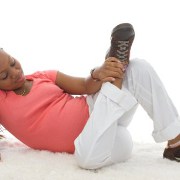 Photo: Getty Images
Photo: Getty Images
Pregnancy can drain your energy, especially during the first trimester. Some women experience bouts of nausea that make exercise seem like an impossibility. Even on good days you may rightfully worry that certain types of exercise could endanger your growing baby. But being pregnant doesn’t mean you have to sit around on a couch all day eating bon-bons (thought that does sound somewhat appealing!). In fact, getting regular exercise throughout pregnancy—at least 30 minutes a day—can improve sleep, increase your energy level during waking hours, alleviate back pain, reduce constipation, bloating and swelling, and keep your muscles strong and toned as you prepare for childbirth. And despite what you may think, running during pregnancy can be perfectly safe and even beneficial.
In a Runner’s World article from October 2010, New York obstetrician Kathryn Peck Rutenberg offered reassurance for pregnant runners. “Each woman and each pregnancy is different,” she said, “but if there are no complications, runners can keep running.”
While it is certainly okay for runners to keep running, women generally should not begin a running regimen after becoming pregnant. Talking with a health care practitioner before beginning any exercise program is advisable.
The American Congress of Obstetricians and Gynecologists (ACOG) has said that running during pregnancy may be safe if you were a pre-pregnancy runner. Rutenberg noted that, while you can continue running the same amount as you did pre-pregnancy, you should do so at a slower pace during pregnancy. A 10-minute miler may slow down to a 13- or 14-minute pace per mile and still feel equally challenged.
A number of factors contribute to the need to slow down during pregnancy. Physiologically, a pregnant woman experiences an increase in blood volume of 30 to 50 percent, allowing her to share oxygen and nutrients with her baby. This increased blood volume requires the heart to work harder; with a higher resting heart rate, exercise needs to slow down in order to keep within a safe heart rate range. If you can talk comfortably while exercising, your heart rate is probably in this safe range.
As the enlarged uterus presses up on the diaphragm, breathing can become more difficult. A slower running pace can help you breathe more steadily and efficiently.
Hormonal changes during pregnancy also should be taken into consideration when planning an exercise routine. Some women experience nasal congestion and respiratory infections as a result of hormonal changes. This, in conjunction with changing lung volume throughout pregnancy, can impact a woman’s ability to keep up with vigorous exercise. You may lose your breath more easily and risk overexerting yourself. Listening to your body during pregnancy is critical to your and your baby’s well-being.
Furthermore, the hormone relaxin loosens, or relaxes, a pregnant woman’s joints and ligaments. While imperative for a successful labor and birth, this added mobility of the joints and ligaments can increase risk of sprains and other injuries. Stretching and exercising to about 75 or 80 percent of your capability is a good gauge and can help you prevent injury.
ACOG listed symptoms that warrant stopping exercise and calling your doctor. These include vaginal bleeding, dizziness, increased shortness of breath, chest pain, headache, weak muscles, calf pain, swelling, contractions, decreased fetal movement and fluid leaking from the vagina.
If you love running, there is a good chance you can continue hitting the pavement during your pregnancy as long as you are willing to make adjustments to your pre-pregnancy routine. Keeping up a safe, regular exercise routine can help you feel better during pregnancy, can help keep your weight gain in check, and may even ease your labor and birth.
Sources:
”Doctor’s Orders,” Runner’s World, October 2010
“Exercise During Pregnancy,” American Congress of Obstetricians and Gynecologists
”The Pregnant Runner,” Runner’s World, February 2008
Reviewed July 14, 2011
by Michele Blacksberg R.N.
Edited by Alison Stanton





Add a Comment1 Comments
To protect vulnerable joints, pregnant runners should avoid running downhill, on concrete, and on uneven surfaces.
July 15, 2011 - 2:38pmBeFit-Mom
This Comment